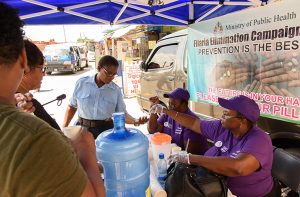The second round for the Mass Drug Administration (MDA) campaign to eliminate Lymphatic Filariasis began on Monday across schools and fixed points in Region Three.
Regional Health Officer (RHO) Dr. Naail Uthman, who is the regional coordinator for the MDA, visited some of the schools where the pills were being distributed. Coordinator of the Neglected Infectious Disease Programme and the National Coordinator for the Elimination of Lymphatic Filariasis Campaign, Dr. Fabu Moses shared the schedule for the rollout of the MDA. According to her, Region Three will be targeted in the first and second weeks of October; Region Four in the second and third weeks; Region Five: in the third and fourth weeks while Region Ten will be targeted in the final week of October and first week of November.
Though the MDA continues in the same four regions that it began in last year, Dr. Moses said: “We have added the other six regions of Guyana, however in a different capacity.”
She explained, “What we’re doing simultaneously in the other regions of Guyana is a remapping survey.”
This remapping survey is a follow up to the 2001 survey that was done for the previous MDA the country had engaged in then. This 2001 survey had identified Regions Three, Four, Five and Ten as having the highest prevalence of Filariasis and as such, work began in those regions last year.

The survey, according to her, will see trained personnel visiting schools to take blood samples from children ages 6-14 whose parents have given their consent. These samples will help to show the prevalence of the microfilariae which signals that the children may have filariasis. If an area has more than two percent prevalence, the MDA will be done there as well.
For the MDA to be successful, generally, 65 per cent of the total at-risk population must be administered the pills. The pills, Diethylcarbamazine Citrate (DEC) and Albendazole (ALB) must be taken once every year for five consecutive years for them to be effective in eliminating the disease. Three DEC pills are given, along with one ALB pill; these are responsible for eradicating the bacteria.
The first round of the MDA was completed last year, it was reported that a whopping 86 per cent coverage was recorded from the four regions targeted. This year, Dr. Moses said that she is confident that more persons will take the pills and safeguard against Filariasis since more people seem to be buying-into the MDA.
“It’s encouraging to see people take their health so seriously, especially since it’s a hidden disease and people can easily shy away,” she said while adding: “It’s encouraging to see that they are bringing sort of a community spirit to get their health fixed for everybody.”
Lymphatic Filariasis (LF) or ‘Filaria’, as it is more commonly called affects the body’s lymphatic system, which functions to remove unwanted fluids from the body and transports ‘lymph’- a fluid which contains white bloods cells that help to fight infections. The World Health Organisation (WHO) states that this disease is caused by infection with parasitic worms called nematodes, classified as ‘filarial worms’. In Guyana, filariasis is caused by the wuchereria bancrofti worm and is transmitted from human to human by the culex mosquito.




.jpg)










